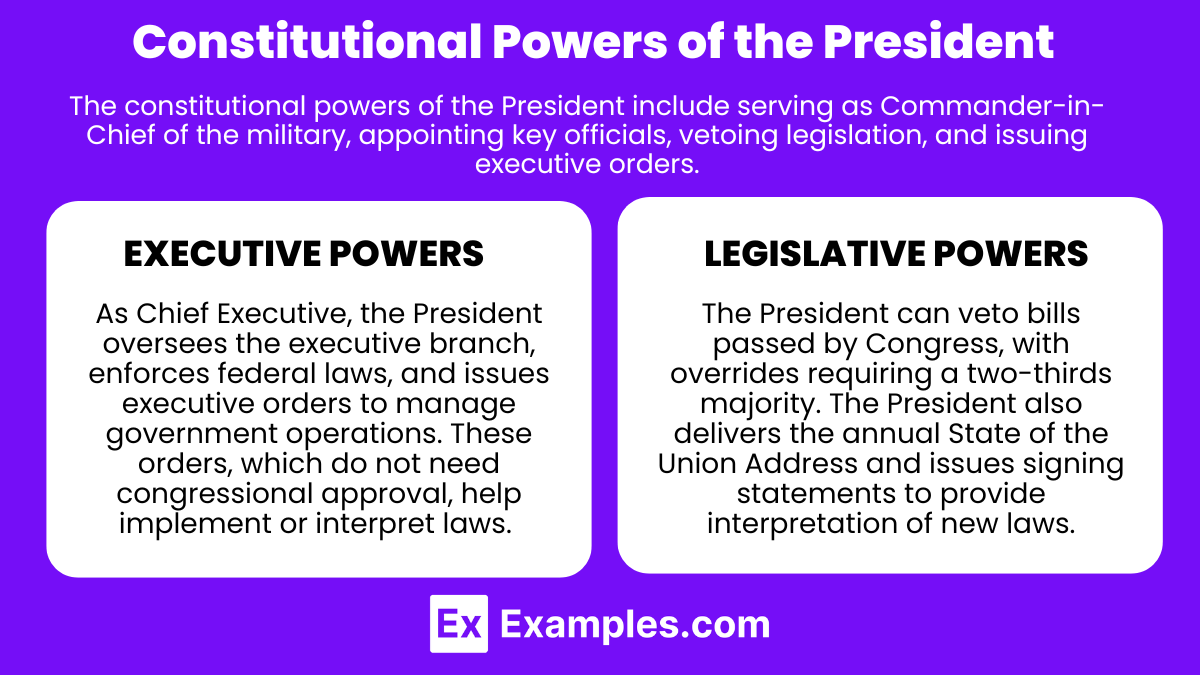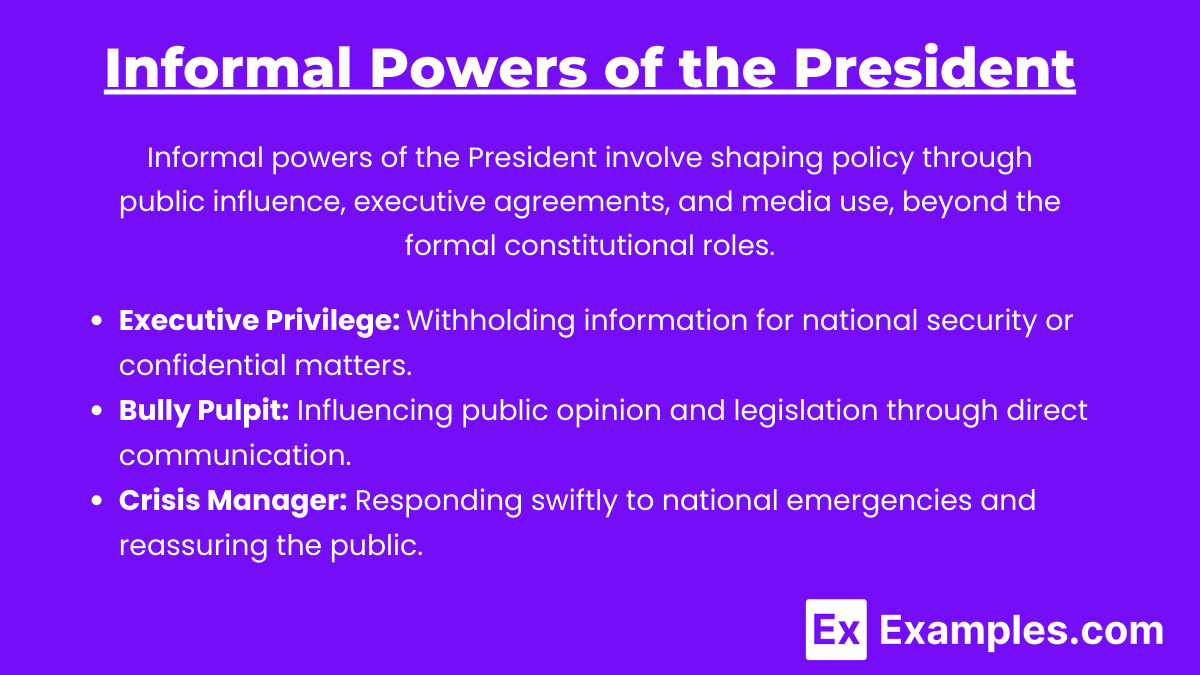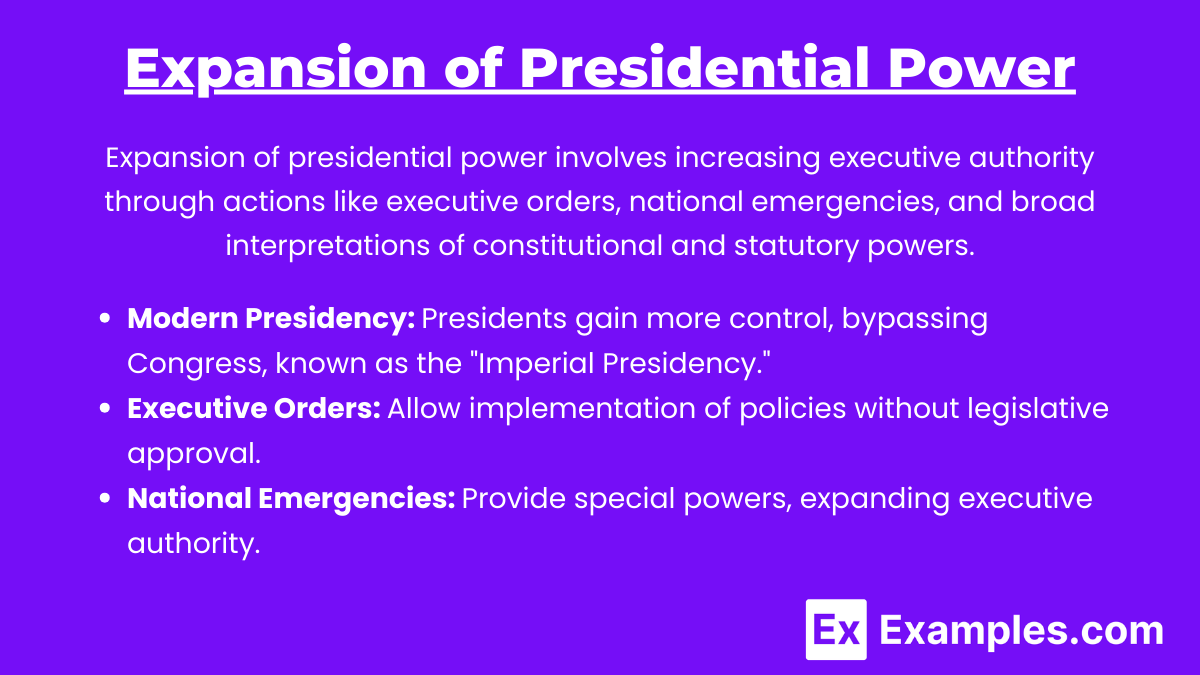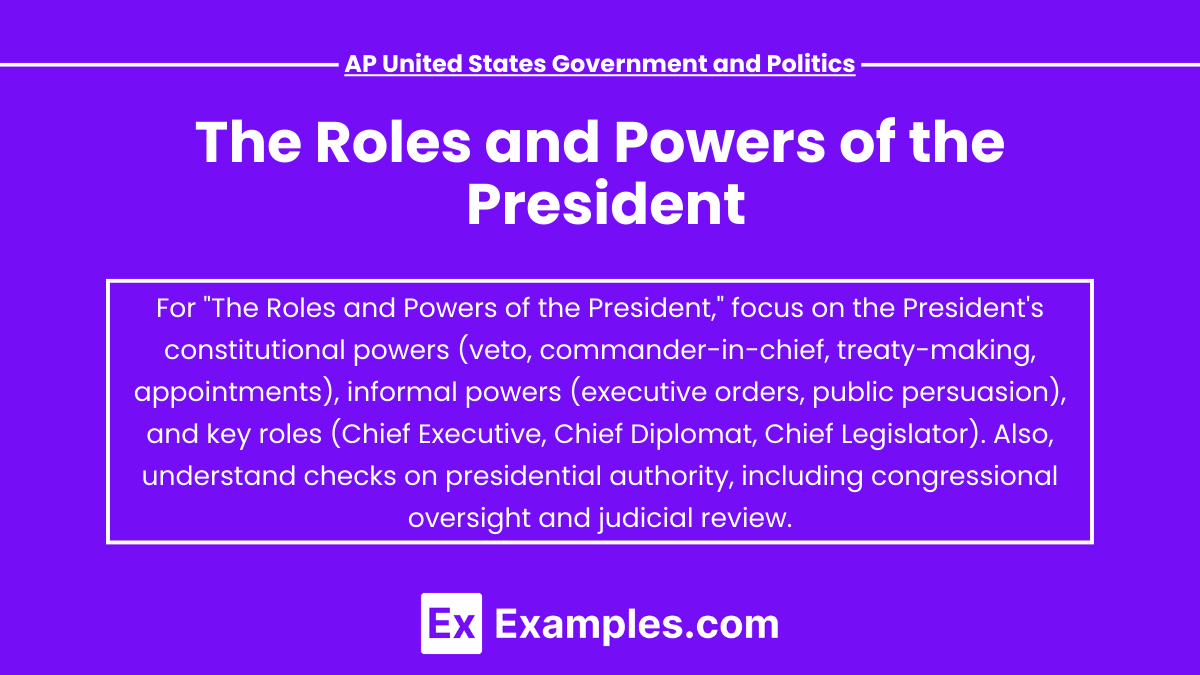The President of the United States holds a central role in the federal government, combining executive, diplomatic, military, and legislative functions. As outlined in the Constitution, the President is responsible for enforcing laws, commanding the armed forces, negotiating treaties, and appointing key government officials. In addition to these formal powers, the President wields significant informal influence through executive orders, vetoes, and public persuasion. Understanding the roles and powers of the President is essential for analyzing U.S. governance and political dynamics.
Learning Objectives
In studying “The Roles and Powers of the President” for the AP United States Government and Politics exam, you should focus on understanding the President’s constitutional powers, such as veto authority, command over the military as Commander-in-Chief, the ability to negotiate treaties, and the power to appoint federal officials. You should also examine the President’s roles as Chief Diplomat, Chief Legislator, and Chief Executive, including how these functions shape policy domestically and internationally. Additionally, recognize the informal powers, like executive orders and the “bully pulpit,” and how they expand presidential influence. Lastly, explore the checks and balances on presidential authority, including congressional oversight and judicial review.
1. Constitutional Powers of the President

The U.S. Constitution (Article II) outlines the formal powers of the President. These powers include the ability to veto legislation, command the armed forces, negotiate treaties, appoint officials, and ensure that laws are faithfully executed.
Executive Powers
- Chief Executive: The President oversees the executive branch, ensuring that federal laws are enforced. This includes appointing heads of federal agencies, such as cabinet members, and issuing executive orders to manage the operations of the federal government.
- Executive Orders: These are directives issued by the President to federal agencies, often used to implement or interpret laws passed by Congress. Executive orders do not require congressional approval but must comply with the Constitution.
- Appointing Power: The President appoints federal judges, ambassadors, and key government officials, often with the Senate’s advice and consent.
Legislative Powers
- Veto Power: The President has the power to veto legislation passed by Congress. A presidential veto can be overridden only by a two-thirds majority in both houses of Congress.
- State of the Union Address: The President is required to deliver an annual address to Congress, outlining the administration’s policy goals and legislative agenda.
- Signing Statements: While not a constitutional power, Presidents often issue signing statements when signing bills into law, providing interpretation or raising constitutional objections.
2. Roles of the President

The President’s roles expand beyond the constitutional powers and involve various functions that influence both domestic and foreign policy.
Chief Diplomat
As the Chief Diplomat, the President leads U.S. foreign policy, negotiating treaties, and conducting diplomacy with other nations. The President also appoints ambassadors and represents the U.S. in international organizations like the United Nations.
- Treaty-Making Power: While the President negotiates treaties, they must be ratified by a two-thirds majority in the Senate.
- Executive Agreements: Unlike treaties, executive agreements do not require Senate approval and are used more frequently to make international agreements.
Commander-in-Chief
The President serves as the Commander-in-Chief of the U.S. armed forces, with the authority to direct military operations. While Congress has the power to declare war, the President can deploy troops without a formal declaration, especially in emergencies.
- War Powers Resolution: Passed in 1973, this limits the President’s ability to commit troops to combat for more than 60 days without congressional authorization.
Chief Legislator
As Chief Legislator, the President plays an essential role in shaping the legislative agenda. Though the President cannot introduce bills, they can influence legislation through lobbying, the veto power, and public appeals.
- Veto Power: Allows the President to reject bills passed by Congress, influencing the legislative process.
- Agenda Setting: The President’s legislative priorities are often communicated in the annual State of the Union Address.
Chief of State
In this ceremonial role, the President acts as the symbolic leader of the nation, representing the U.S. in ceremonial functions, both domestically and internationally.
- Ceremonial Duties: The President attends state dinners, awards honors, and represents the country at official functions.
Party Leader
As the leader of their political party, the President shapes the party’s platform, raises funds, and supports party candidates in elections.
- Political Influence: The President often works to unify party members and promote their legislative agenda through party networks.
3. Informal Powers of the President

In addition to formal constitutional powers, the President has various informal powers, which are critical for executing their duties effectively. These powers often evolve over time, influenced by the political climate and the President’s personal leadership style.
- Executive Privilege: This allows the President to withhold information from Congress or the courts in matters of national security or confidential executive deliberations.
- Bully Pulpit: The President’s unique ability to appeal directly to the public to shape opinions and influence the legislative process. This is often achieved through speeches, social media, or public appearances.
- Crisis Manager: In times of national emergencies (e.g., natural disasters, terrorist attacks), the President is expected to act swiftly to manage the situation and reassure the public.
4. Checks on Presidential Power

Despite the President’s significant authority, the Constitution includes various checks and balances to prevent any abuse of power.
- Congress: Congress can check the President by overriding vetoes, controlling the budget, and exercising impeachment powers. The Senate’s role in confirming appointments and ratifying treaties also limits presidential authority.
- Judicial Review: The Supreme Court has the power to review executive actions and declare them unconstitutional.
- Public Opinion: Presidents rely heavily on public support to accomplish their goals. Low approval ratings can weaken a President’s ability to influence Congress or gain re-election.
5. Expansion of Presidential Power

Over time, the role of the President has expanded, particularly in times of crisis or war. For instance, Franklin D. Roosevelt’s New Deal policies during the Great Depression and George W. Bush’s actions after the 9/11 attacks demonstrated how Presidents can assume greater authority during emergencies.
- Modern Presidency: In the 20th and 21st centuries, Presidents have gained more control over both domestic and foreign policy, often bypassing Congress through executive orders or agreements. This trend is sometimes referred to as the “Imperial Presidency.”
- Executive Orders: Presidents use executive orders to implement policies and manage the federal government, expanding their influence beyond legislative approval.
- National Emergencies: Declaring national emergencies allows Presidents to access special powers and resources, often leading to an expansion of executive authority.
Examples
Example 1 : Veto Power
The President holds the authority to veto legislation passed by Congress, preventing a bill from becoming law unless Congress overrides the veto with a two-thirds majority in both houses. For example, President Barack Obama used the veto power on several occasions, including his veto of the Keystone XL Pipeline Approval Act in 2015, which Congress failed to override.
Example 2 : Commander-in-Chief
As the Commander-in-Chief of the armed forces, the President has the authority to direct military operations and make key decisions regarding national defense. An example is President George W. Bush’s use of this power to lead the U.S. military into Afghanistan following the 9/11 attacks.
Example 3 : Executive Orders
The President can issue executive orders to direct the activities of the federal government. For instance, President Franklin D. Roosevelt issued Executive Order 9066 during World War II, which authorized the internment of Japanese Americans, demonstrating the significant impact of executive orders.
Example 4 : Treaty Negotiation and Ratification
The President negotiates treaties with foreign nations, which must then be ratified by a two-thirds vote in the Senate. For example, President Woodrow Wilson negotiated the Treaty of Versailles after World War I, though the Senate ultimately rejected its ratification.
Example 5 : Appointment Power
The President appoints federal judges, cabinet members, and ambassadors, often with the Senate’s advice and consent. A notable example is President Donald Trump’s appointment of three U.S. Supreme Court Justices—Neil Gorsuch, Brett Kavanaugh, and Amy Coney Barrett—shaping the future of the judiciary.
Multiple Choice Questions
Question 1
Which of the following is an example of the President’s role as Chief Diplomat?
A) Declaring war on another country
B) Negotiating treaties with foreign nations
C) Issuing pardons for federal crimes
D) Vetoing a bill passed by Congress
Answer: B) Negotiating treaties with foreign nations
Explanation: As Chief Diplomat, the President represents the U.S. in foreign affairs and has the power to negotiate treaties with other nations. These treaties, however, must be ratified by a two-thirds vote in the Senate. Declaring war (A) is a power of Congress, pardoning (C) falls under the President’s judicial powers, and vetoing (D) is a legislative function.
Question 2
What is required for Congress to override a presidential veto?
A) A simple majority in both the House and the Senate
B) A unanimous vote in both chambers
C) A two-thirds majority in both the House and the Senate
D) The approval of the Supreme Court
Answer: C) A two-thirds majority in both the House and the Senate
Explanation: To override a presidential veto, Congress must achieve a two-thirds majority vote in both the House of Representatives and the Senate. This high threshold ensures that a vetoed bill cannot easily become law without significant support in Congress. A simple majority (A) is not sufficient to override a veto, and the Supreme Court (D) has no role in this process.
Question 3
Which of the following roles of the President involves acting as the symbolic leader of the country and representing the nation in ceremonial events?
A) Chief Executive
B) Commander-in-Chief
C) Chief of State
D) Chief Legislator
Answer: C) Chief of State
Explanation: As Chief of State, the President serves as the symbolic leader of the nation, representing the U.S. at ceremonial events and performing duties such as awarding honors and meeting foreign leaders. The Chief Executive role (A) involves enforcing laws, Commander-in-Chief (B) involves military leadership, and Chief Legislator (D) refers to the President’s influence on the legislative process.


